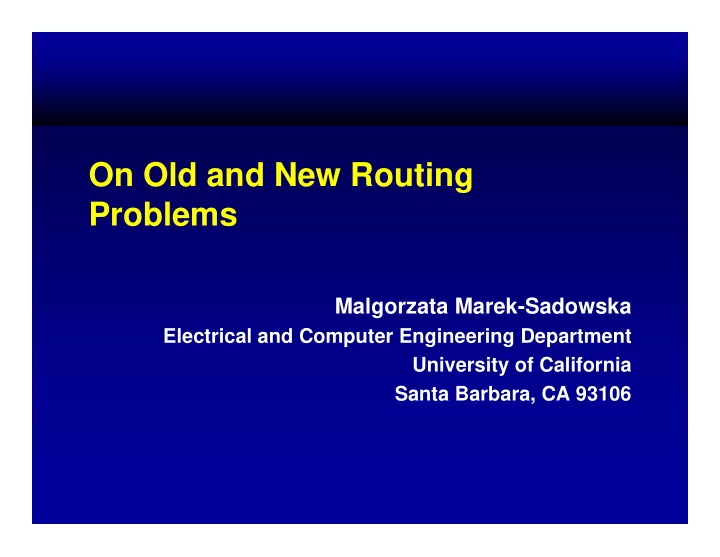

On Old and New Routing Problems Malgorzata Marek-Sadowska Electrical and Computer Engineering Department University of California Santa Barbara, CA 93106
A Short History of Interconnect Routing Time Period Advances in Routing 1800 s Geometric Steiner problem, Hamiltonian path (traveling salesman) formulated. 1960 -1969 Point-to-point routing algorithms (Lee’s maze and Hightower’s line search). 1965 -1975 Layout tools first developed for printed circuit boards. First abstract multi-net optimization problems formulated. 1975 -1985 Planar routing, more sophisticated graph models, VLSI layout styles and various abstract routing problems formulated. 1985 -1990 First performance-driven tools , clock routing, power and ground routing; graph theory, computational geometry, algorithm complexity techniques/concepts applied to routing problems. 1990 -2000 Over-the-cell routing, 3D and multilayer placement and routing techniques developed. Routability driven design. Routing + electrical constraints = physical synthesis introduced. 2000 - now DFM driven routing; dramatic algorithmic improvements. 2
Kuh‘s Group Contributions Time Period Advances in Routing 1800 s Geometric Steiner problem, Hamiltonian path (traveling salesman) formulated. 1960 -1969 Point-to-point routing algorithms (Lee’s maze and Hightower’s line search). 1965 -1975 Layout tools first developed for printed circuit boards. First abstract multi-net optimization problems formulated. 1975 -1985 Planar routing, more sophisticated graph models, VLSI layout styles and various abstract routing problems formulated. 1985 -1990 First performance-driven tools , clock routing, power and ground routing; graph theory, computational geometry, algorithm complexity concepts applied to routing problems. 1990 -2000 Over-the-cell routing, 3D and multilayer placement and routing techniques developed. Routability driven design. Routing + electrical constraints = physical synthesis introduced. 2000 - now DFM driven routing; dramatic algorithmic improvements. 3
Overview Interconnect Routing Automation in Kuh’s Group PCB Wiring and Single Row Routing Building Block style layout Wire Coupling Minimization Post-routing Topology Optimization for Clock and Power Networks Research Problems 4
PCB Routing capacitor chip chip Printed Circuit Board Many layers Relatively large area Low performance Modern designs: High-density fine-pitch packages Large pin counts 5
PCB Routing Formulation The model: The board has a fixed geometry and many layers Each layer has fixed platted through holes uniformly spaced on grid Every other column of holes consists either of conductor pins reaching all layers, or vias Problem: Connect the module terminals using wires, pins and vias. Key abstraction: single row routing problem. 6
Single Row Routing Problem 1 2 3 1 3 4 1 4 2 7
8 2 2 4 Single Row Routing Problem 4 N4 1 1 4 4 3 3 N3 2 2 N2 3 3 N1 2 2 1 1 (b) (a)
What is special about Single Row? Key properties of the single row routing representation Interval ordering determines completely the routing solution Defines a topological to geometric mapping First time routing of many nets was addressed simultaneously Inspired topological routing research Recently, the model has been used for wireless cellular network channel assignment 9
Building Block Layout Blocks differ in size and shape Difficult to automate Irregular routing area Blocks can move Two approaches to routing: Fracture the routing region; route the sub-regions and adjust block placement. Fix the block positions and make all connections (routing may be too loose or design rules violated); apply compaction/decompaction. 10
Channel Definition and Ordering 3 3 Geometric channels 1 1 4 4 2 2 11 2 Topological channels 4 1 3
Building Block Routing Floor Planner (Placer) + Global Router Global Global Spacer Rerouter Channel Definition/Ordering Local Router Local Local Spacer Rerouter 12
13 Dynamic routing update
Building Block Layout – Contributions Channel router (Yoshimura and Kuh) Prototype system developed Computational geometry and graph theory techniques applied to formulate and solve Channel definition and ordering L-channel count minimization Dynamic updating of global routing Gridless router Follow up Rubber-band routing MCM routing 14
Interconnect Optimization Wire Coupling and Crosstalk Delay Noise: Increases/Decreases Delay Can be controlled (mitigated) by Spacing (detailed routing) Global routing modification Spacing Aggressor 1 C c1 Victim Net ordering C c2 Aggressor 2 15
Static Timing Analysis Determines net sensitivity to coupling Not all nets are sensitive to crosstalk Region-based crosstalk risk bounds PO PI 16
Coupling constraints within a region a b a 3 1 d 4 2 g c f d 3 c 5 1 f b 2 b b a a 3 3 1 1 4 4 2 2 2 c c d d 5 3 1 3 5 1 1 f g f 2 2 17
Interconnect Optimization Power and Ground Nets Enhancement buses Formulation of an enhancement bus selection and sizing problem. Observation that adding a bus may cause local current crowding This problem has not been fully explained yet. Vdd Gnd 18
Clock Optimization Multi-link insertion and wire sizing Performance improvement of an existing net topology after global routing. Detail analysis of the link insertion impact on maximum delay and skew of any arbitrary topology A link insertion and wire sizing algorithm that can achieve the best performance improvement. 19
Post-Routing Optimization: Contributions Deep analysis of practical interconnect optimization problems including Cross talk reduction Clock and power network topology optimization Efficient optimization approaches proposed Many follow up works on Crosstalk reduction Clock link insertion 20
Some (Still Open) Research Problems Routing Complexity/ Technology Scaling Implied Problems Global Routing Routing for Manufacturability Routing for ECO and Debugging Power Grid Topology Optimization Routing for New Transistor Technologies 21
Recommend
More recommend